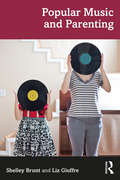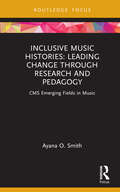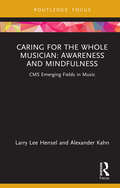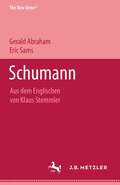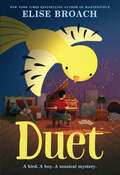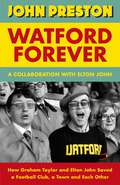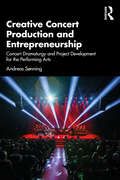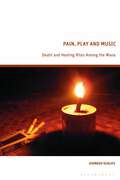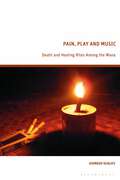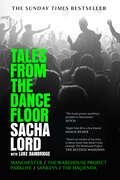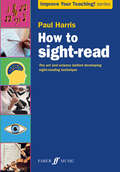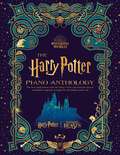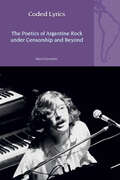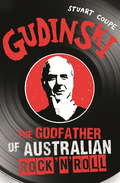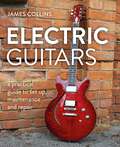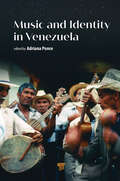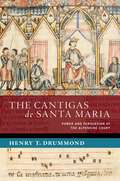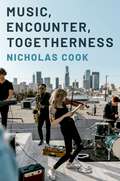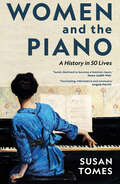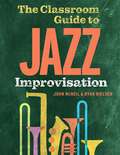- Table View
- List View
Popular Music and Parenting
by Shelley Brunt Liz GiuffrePopular Music and Parenting explores the culture of popular music as a shared experience between parents, carers and young children. Offering a critical overview of this topic from a popular music studies perspective, this book expands our assumptions about how young audiences and caregivers engage with music together. Using both case studies and wider analysis, the authors examine music listening and participation between children and parents in both domestic and public settings, ranging across children's music media, digital streaming, live concerts, formal and informal popular music education, music merchandising and song lyrics.Placing young children’s musical engagement in the context of the music industry, changing media technologies, and popular culture, Popular Music and Parenting paints a richly interdisciplinary picture of the intersection of popular music with the parent–child relationship.
Inclusive Music Histories: CMS Emerging Fields in Music (CMS Emerging Fields in Music)
by Ayana O. SmithInclusive Music Histories: Leading Change through Research and Pedagogy models effective practices for researchers and instructors striving either to reform music history curricula at large or update individual topics within their classes to be more inclusive. Confronting racial and other imbalances of Western music history, the author develops four core principles that enable a shift in thinking to create a truly intersectional music history narrative and provides case studies that can be directly applied in the classroom. The book addresses inclusivity issues in the discipline of musicology by outlining imbalances encoded into the canonic repertory, pedagogy, and historiography of the field. This book offers comprehensive teaching tools that instructors can use at all stages of course design, from syllabus writing and lecture planning to discussion techniques, with assignments for each of the subject matter case studies. Inclusive Music Histories enables instructors to go beyond token representation to a more nuanced music history pedagogy.
Caring for the Whole Musician: CMS Emerging Fields in Music (CMS Emerging Fields in Music)
by Larry Lee Hensel Alexander KahnCaring for the Whole Musician brings together insights from two expert musicians and educators to consider the relationship between mental and physical health and artistic practice for musicians. Offering a holistic perspective that encompasses the whole being – body, mind, and heart – this book provides emerging musicians with tools, practices, and mindsets to address key challenges throughout their journey.The first part, Awareness, addresses wellness and embodiment in music, exploring how our bodies are constructed and how the use of our bodies as instruments affects function. Using approaches including Body Mapping and the Alexander Technique, this part helps readers discover adverse habits that interfere with natural movement, and nurture awareness of the body. The second part, Mindfulness, explores how meditative practice can be incorporated into every stage of concert preparation and embedded within the daily life of the musician. Offering mindfulness exercises related to each stage of the music-making process, these chapters provide strategies for readers to enhance their well-being and focus.Centered in the understanding of the musician as a whole being, this book provides an essential guide to how practices of awareness and mindfulness can allow musicians to better care for themselves and flourish in their artistic careers.
Duet
by Elise Broach★ &“Exceptional…. Rich with facts around goldfinches and music, vivid descriptions, unique characters, and carefully crafted suspense.&” —Publishers Weekly, starred review ★ &“Perfect for readers who, like Mirabelle, are sometimes spellbound by music.&” —Booklist, starred reviewA musically gifted bird, a piano-playing boy, and a real-life mystery involving three artistic geniuses Welcome to the world of Mirabelle, a young goldfinch who loves to sing and dreams of becoming a musical star. She lives with her family in the backyard of a piano teacher, and she is quickly intrigued by Mr. Starek's newest pupil. Michael Jin is an eleven-year-old keyboard sensation, but lesson after lesson, he refuses to play. With the prestigious Chopin Festival looming at summer&’s end, how will he be ready in time? Mirabelle is responsible for Michael&’s breakthrough—to her own astonishment, she sings the Chopin piece he is beginning to play at the piano. It is their first duet. Thus begins a secret adventure that will take Mirabelle and Michael further than they ever imagined—in music, in friendship, and in solving the mystery of a lost piano that could be worth millions. A house full of treasures holds the clues. There, Mirabelle, Michael, and their friend Emily will make an important discovery that links the great composer Frederic Chopin, the trailblazing author George Sand, and the French Romantic painter Eugene Delacroix. A fast-paced, history-rich mystery will have young readers hooked as they root for boy and bird in this beautifully told novel, full of emotion and suspense.A Bank Street College Best Book of the Year A Junior Library Guild Gold Standard Selection
Watford Forever: How Graham Taylor and Elton John Saved a Football Club, a Town and Each Other
by John Preston Elton JohnThe Sunday Times Sports Book of the Year A Times Book of the Year A Financial Times Book of the YearA Guardian Book of the YearA New Statesman Book of the Year'The heartwarming story of the collaboration and friendship between English football’s oddest couple, Elton John and Graham Taylor' The Times ' A wonderful, feel-good account of an ultimately English provincial story' Simon Kuper_____________________ An unforgettable British underdog story from one of our greatest narrative nonfiction writers, John Preston, and the international musical icon and bestselling author, Sir Elton John.Britain in the 1970s was beset by unrest and unemployment, as inflation soared, fuel was scarce, and hooliganism was on the rise. And for Watford FC, the outlook was even gloomier. Rundown and rat-infested, Watford were an ailing side with holes in their kit and barely enough fans to fill a stand. Of the 92 clubs in the Football League, spread across four divisions, Watford were in 92nd place.Meanwhile, Elton John was the most successful rockstar in the world. With six-inch platforms, spangled jumpsuits, and peroxide hair, he was glamorous, gay, and seemingly a world away from the semi-detached house in Pinner where he had supported Watford FC as a child. Many assumed he would move to America. Instead, he bought the football club.Watford Forever is the remarkable story of Elton John's ownership of Watford FC and its transformational journey to the top of the First Division under iconic manager Graham Taylor. Perhaps most remarkably, four of the same players who had been written off as has-beens went with them all the way from the bottom to the top. Inspiring and infectiously funny, this is a tribute to football's unlikeliest friendship as Elton John and Taylor, a straight-talking former fullback with a love of Vera Lynn, beat the odds and their personal demons to save a club and a community.Immersed in the grime and glamour of '70s Britain, Watford Forever is one of sport's great underdog stories and a love letter to the beautiful game.
Creative Concert Production and Entrepreneurship: Concert Dramaturgy and Project Development for the Performing Arts
by Andreas SonningCreative Concert Production and Entrepreneurship: Concert Dramaturgy and Project Development for the Performing Arts offers a conceptual and applied introduction to the musical and dramaturgical challenges involved in developing and producing concerts. Drawing from over three decades of real-world experience and a range of international case studies, the author explores new models for cooperation between artists, cultural institutions, governments, and businesses, arguing for the importance of rooting the concert production process in artistic and ethical values. The book presents essential knowledge and techniques to meet the demand for music and stage performances across genres, arenas, formats, and distribution channels. Relevant to a wide range of students and professionals in music and the performing arts, Creative Concert Production and Entrepreneurship marries theory with practice, providing a framework for readers to develop the creative entrepreneurial practices essential for success in today’s music industry.
Creative Concert Production and Entrepreneurship: Concert Dramaturgy and Project Development for the Performing Arts
by Andreas SonningCreative Concert Production and Entrepreneurship: Concert Dramaturgy and Project Development for the Performing Arts offers a conceptual and applied introduction to the musical and dramaturgical challenges involved in developing and producing concerts. Drawing from over three decades of real-world experience and a range of international case studies, the author explores new models for cooperation between artists, cultural institutions, governments, and businesses, arguing for the importance of rooting the concert production process in artistic and ethical values. The book presents essential knowledge and techniques to meet the demand for music and stage performances across genres, arenas, formats, and distribution channels. Relevant to a wide range of students and professionals in music and the performing arts, Creative Concert Production and Entrepreneurship marries theory with practice, providing a framework for readers to develop the creative entrepreneurial practices essential for success in today’s music industry.
Pain, Play and Music: Death and Healing Rites Among the Wana
by Giorgio ScaliciThe Wana people of Morowali accept the experiences of pain, illness and loss and transform them into something positive: rituals that celebrate life, friendship and the community. Through fieldwork with the Wana people of Morowali, Central Sulawesi, Giorgio Scalici shows how music serves as a connection between the human world and the hidden world of spirits and emotion.By examining rituals such as the momago, the main Wana healing ritual, and the kayori, the funeral, this book investigates how music is used by the Wana to heal people, control emotions, reinforce the sense of community and to mark the cultural death of the community member. In this study, music transforms the pain of loss into a playful event that heals the community and assures its future.This book will be of interest to the wider academic study of religion, anthropology and ethnomusicology as it looks as at funerals as healing rituals for the community which lead the living and the dead through critical times.
Pain, Play and Music: Death and Healing Rites Among the Wana
by Giorgio ScaliciThe Wana people of Morowali accept the experiences of pain, illness and loss and transform them into something positive: rituals that celebrate life, friendship and the community. Through fieldwork with the Wana people of Morowali, Central Sulawesi, Giorgio Scalici shows how music serves as a connection between the human world and the hidden world of spirits and emotion.By examining rituals such as the momago, the main Wana healing ritual, and the kayori, the funeral, this book investigates how music is used by the Wana to heal people, control emotions, reinforce the sense of community and to mark the cultural death of the community member. In this study, music transforms the pain of loss into a playful event that heals the community and assures its future.This book will be of interest to the wider academic study of religion, anthropology and ethnomusicology as it looks as at funerals as healing rituals for the community which lead the living and the dead through critical times.
Tales from the Dancefloor: Manchester / The Warehouse Project / Parklife / Sankeys / The Haçienda
by null Sacha LordLike most Mancunians of his age, Sacha Lord's life has been a tale of two cities. Then and now. Over the past three decades, Sacha has been in the eye of the storm of a musical and cultural revolution, from The Haçienda to The Warehouse Project. He has worked with the music industry’s most iconic acts including the Prodigy, New Order, Snoop Dogg, Fat Boy Slim, Skrillex, Calvin Harris, Four Tet, Fred again … and has thrown some of the biggest parties that the UK has ever seen. But it wasn’t an easy journey getting there. Tales from the Dancefloor gives readers an all-access pass to the people, music and chaos behind the scenes. From being shot at in a drive-by shooting and dealing with gangs and the criminal underworld, to the excess and demands of some of music’s biggest names, launching the country’s largest urban festival, Parklife, and much more, Sacha reveals all the highs and lows for the very first time. Tales from the Dancefloor, co-authored with bestselling author Luke Bainbridge, is a love letter to the city and the dance floor. This is an incredible story of resilience, creativity and innovation.
How to sight-read (Improve your teaching)
by Paul HarrisThe full eBook version of How to sight-read in fixed-layout format. Do you believe that some people can sight-read and others can't? In How to sight-read, Paul Harris dispels this and other common misconceptions about sight-reading, presenting instead the idea of sight-reading as a technique that can be developed and learned by anyone. He breaks down the fascinating science behind sight-reading as well as providing practical advice and exercises that can be incorporated into both lessons and practice. The engaging activities in the book are supported by a unique accompanying web app enabling readers to improve key areas of sight-reading technique including rhythm, pattern recognition, and brain processing speed. Written to help students, parents and teachers alike, How to sight-read challenges existing perspectives on sight-reading and presents an innovative new approach to teaching and learning this vital musical skill. 'This book has elevated sight-reading practice to the next level, using a fresh, fun approach that blends solid vision, science principles, and 21st-century technology.' Debra Grant BSc (Hons) MCOptom 'Paul Harris has offered the concept that sight-reading is simply a technique that can be easily learnt by us all... This is a mustread for music students and teachers.' John Hutchins, Director Junior Academy and LRAM, Royal Academy of Music
The Harry Potter Piano Anthology
by John Williams Alexandre Desplat James Newton Howard Nicholas HooperThe full eBook version of The Harry Potter Piano Anthology in fixed-layout format. The Harry Potter Piano Anthology contains 56 of the biggest and best musical themes from the Harry Potter and Fantastic Beasts films, arranged for intermediate level piano. From the best-loved John Williams tunes Hedwig's Theme and Harry's Wondrous World, to The Crimes of Grindelwald and Dumbledore's Theme from the Fantastic Beasts films, this book has been created for pianists to enjoy and return to again and again. Transport yourself to the magical world of Harry Potter with this stunning piano anthology - featuring an exclusive, bespoke cover by MinaLima, the graphic design studio behind the Wizarding World.
Coded Lyrics: The Poetics of Argentine Rock under Censorship and Beyond (Liverpool Latin American Studies #31)
by Mara FavorettoCoded Lyrics is the first comprehensive academic work dedicated to unraveling the lyrical intricacies of Argentine rock in the English language. This book redefines the narrative of rock history, shedding light on the distinctive journey undertaken by South American rock music amidst a unique set of contextual challenges, far removed from its English-speaking counterparts. Within this vibrant musical landscape, Argentine rock emerges as a shining example of cultural resistance in the region. Focusing intently on Argentina's tumultuous authoritarian decades and the post-dictatorship era, this book delves deep into the heart of the Argentine rock genre's lyrical content. It vividly portrays the ongoing struggle between the state and the public, where identity, language, and perception converge around the powerful medium of rock music. Coded Lyrics is not a conventional musicological study; instead, it serves as a meticulous exploration of language and culture. With captivating prose, the book unravels the genesis of Argentine rock, placing language at its epicentre. Through a thorough examination of rock lyrics, this work unveils the artful manipulation of language as a vehicle for resistance. It illuminates the unexpected consequences of censorship in Argentina, with Argentine rock lyrics standing as a compelling testament to the transformative power of art in the face of totalitarianism.
Gudinski: The Godfather of Australian Rock
by Stuart CoupeThe real story of the man behind the bands - and a backstage pass to forty years of Australian rock music.Known to many as GODinski, Michael Gudinski is unquestionably the most powerful and influential figure in the Australian rock'n'roll music business - and has been for the last four decades.Often referred to as 'the father of the Australian music industry', he has nurtured the careers of many artists - Kylie Minogue, Jimmy Barnes, Paul Kelly, Skyhooks, Split Enz, Yothu Yindi, to name just a few. But his reach isn't limited to Australian artists. With his Frontier Touring Company, Gudinski has toured The Rolling Stones, Frank Sinatra, Bob Dylan, Bruce Springsteen, Madonna, Sting ... pretty much a who's who of the arena level international music scene.A self-made multi-millionaire, Gudinski is the Australian equivalent of Richard Branson or David Geffen, but who is this tough, inspired, flamboyant and impassioned businessman who has shaped Australian popular culture? Where did he come from, and how has he stayed relevant for so long in an industry notorious for its fickleness? Rock journalist Stuart Coupe delves into Gudinski's life to find the answers - and in doing so gives us a backstage pass to forty years of Australian rock.
Electric Guitars: A Practical Guide to Set Up, Maintenance and Repair
by James CollinsThis practical guide considers everything you need to know, from the instrument's initial set up through to maintenance and repairs. An invaluable resource for beginners who want to learn to set up and look after their guitars, to aspiring and professional touring techs who want to work on other people's guitars.
Music and Identity in Venezuela
by Adriana PonceVenezuelan music has remained largely unnoticed in the academic English literature. Boasting a tremendous wealth of traditions, it displays influences from the Spanish, indigenous, and enslaved African communities that populated the territory from the “conquest” on and offers a tremendous diversity of genres and styles that vary by region, occasion, time, and sometimes ethnic influences. This book presents critical discussions of some of these traditions in connection with the issue of identity. The discussions capture country and city life, illustrate foundational myths, bring secular traditions closer to Christianity, explore surviving cultural strategies, et cetera. They also analyze the interface between Venezuelan identity and European classical music. The book displays diversity of perspectives in terms of (a) subject matter, as it includes traditional and concert musics; (b) disciplines on which the inquiries are grounded, as it includes essays by scholars and artists from musicology, performance, composition, history, cultural history, and education; and (c) epistemological approaches, as it includes critical, historical, and ethnographic research.
Music and Identity in Venezuela
Venezuelan music has remained largely unnoticed in the academic English literature. Boasting a tremendous wealth of traditions, it displays influences from the Spanish, indigenous, and enslaved African communities that populated the territory from the “conquest” on and offers a tremendous diversity of genres and styles that vary by region, occasion, time, and sometimes ethnic influences. This book presents critical discussions of some of these traditions in connection with the issue of identity. The discussions capture country and city life, illustrate foundational myths, bring secular traditions closer to Christianity, explore surviving cultural strategies, et cetera. They also analyze the interface between Venezuelan identity and European classical music. The book displays diversity of perspectives in terms of (a) subject matter, as it includes traditional and concert musics; (b) disciplines on which the inquiries are grounded, as it includes essays by scholars and artists from musicology, performance, composition, history, cultural history, and education; and (c) epistemological approaches, as it includes critical, historical, and ethnographic research.
Coded Lyrics: The Poetics of Argentine Rock under Censorship and Beyond (Liverpool Latin American Studies #31)
by Mara FavorettoCoded Lyrics is the first comprehensive academic work dedicated to unraveling the lyrical intricacies of Argentine rock in the English language. This book redefines the narrative of rock history, shedding light on the distinctive journey undertaken by South American rock music amidst a unique set of contextual challenges, far removed from its English-speaking counterparts. Within this vibrant musical landscape, Argentine rock emerges as a shining example of cultural resistance in the region. Focusing intently on Argentina's tumultuous authoritarian decades and the post-dictatorship era, this book delves deep into the heart of the Argentine rock genre's lyrical content. It vividly portrays the ongoing struggle between the state and the public, where identity, language, and perception converge around the powerful medium of rock music. Coded Lyrics is not a conventional musicological study; instead, it serves as a meticulous exploration of language and culture. With captivating prose, the book unravels the genesis of Argentine rock, placing language at its epicentre. Through a thorough examination of rock lyrics, this work unveils the artful manipulation of language as a vehicle for resistance. It illuminates the unexpected consequences of censorship in Argentina, with Argentine rock lyrics standing as a compelling testament to the transformative power of art in the face of totalitarianism.
The Cantigas de Santa Maria: Power and Persuasion at the Alfonsine Court (NEW CULTURAL HISTORY OF MUSIC SERIES)
by Henry T. DrummondAlfonso X (1221-84) ruled over the Crown of Castile from 1252 until his death. Known as "the Wise," he oversaw the production of a wealth of literature in his scriptorium. One of the most impressive of these literary outputs is the collection of songs known as the Cantigas de Santa Maria, which by most counts comprises 429 songs preserved in four manuscripts. The miracle songs (or cantigas de miragre) form the focus of this book. While the Cantigas have been the subject of much scholarly attention, only a handful of studies have looked at the repertory through an interdisciplinary lens. Fewer still have probed how the Cantigas use the power of song as a communicative medium, one that functions as a social tool within the erudite environment of the Alfonsine court. This book offers a new perspective to the song collection, probing how the Cantigas use their music and text, together with rhetorical devices, to communicate with their desired audience. Author Henry T. Drummond builds upon previous methodologies, adopting a novel and holistic assessment of the songs' melodies, poetic features, and narrative logic to assess a wide selection of songs. He presents a nuanced understanding of a song form that effectively conveys its narratives to its listeners via a diverse combination of tools, embracing medieval rhetoric, rhyme-based play, and song's inherent ludic potential. Such devices, Drummond argues, allow for the Cantigas to loom large as propaganda pieces, designed to dignify Alfonso X through an elaborately devised courtly ritual.
Music, Encounter, Togetherness
by Nicholas CookIn today's technological and globalised world, music remains a basic dimension of society. Music, Encounter, Togetherness outlines a relational approach to music that creates space for both human agency and social relationship. Throughout the book, author Nicholas Cook puts Euro-American musical traditions into dialogue with other world music cultures, complementing theory-driven approaches with comprehensive case studies ranging from late eighteenth-century India to contemporary China, and from Debussy's encounter with Javanese music and dance to cross-cultural musicking in Australia and in cyberspace. Through these examples, Cook examines how music affords interpersonal relationship and social togetherness, and what happens when musicians from different cultures interact. Central to the book is the idea of encounter, which highlights the dynamic and processual nature of musicking, as much in therapy or at home as in the jazz club or concert hall. Western musicologists have traditionally thought of music as primarily a repertory of objects; Cook illustrates how thinking of it in processual terms--through an expanded idea of performance--can make as much sense of Western art music as of other traditions. In basing an understanding of music on acts rather than objects and focussing on people and their relationships rather than on the impersonal forces of evolutionary or stylistic histories, the book opens up ways of thinking that counter some of the dehumanising aspects of musical thinking and practice in global modernity.
Music, Encounter, Togetherness
by Nicholas CookIn today's technological and globalised world, music remains a basic dimension of society. Music, Encounter, Togetherness outlines a relational approach to music that creates space for both human agency and social relationship. Throughout the book, author Nicholas Cook puts Euro-American musical traditions into dialogue with other world music cultures, complementing theory-driven approaches with comprehensive case studies ranging from late eighteenth-century India to contemporary China, and from Debussy's encounter with Javanese music and dance to cross-cultural musicking in Australia and in cyberspace. Through these examples, Cook examines how music affords interpersonal relationship and social togetherness, and what happens when musicians from different cultures interact. Central to the book is the idea of encounter, which highlights the dynamic and processual nature of musicking, as much in therapy or at home as in the jazz club or concert hall. Western musicologists have traditionally thought of music as primarily a repertory of objects; Cook illustrates how thinking of it in processual terms--through an expanded idea of performance--can make as much sense of Western art music as of other traditions. In basing an understanding of music on acts rather than objects and focussing on people and their relationships rather than on the impersonal forces of evolutionary or stylistic histories, the book opens up ways of thinking that counter some of the dehumanising aspects of musical thinking and practice in global modernity.
Women and the Piano: A History in 50 Lives
by Susan TomesWomen are an essential part of the history of the piano—but how many women pianists can you name? Throughout most of the piano’s history, women pianists lacked access to formal training and were excluded from male-dominated performance spaces. Even the modern piano’s keys were designed without consideration of women’s typically smaller hands. Yet despite their music being largely confined to the domestic sphere, women continued to play, perform, and compose on their own terms. Celebrated pianist and author Susan Tomes traces fifty such women across the piano’s history. Including now-famous names such as Clara Schumann and Fanny Mendelssohn, Tomes also highlights overlooked women: from Hélène de Montgeroult, whose playing saved her life during the French Revolution, to Leopoldine Wittgenstein, influential Viennese salonnière, and Hazel Scott, the first Black performer in the United States to have a nationally syndicated TV show. From Maria Szymanowska to Nina Simone, and including interviews with women performing today, this is a much-needed corrective to our understanding of the piano—and a timely testament to women’s musical lives.
The Classroom Guide to Jazz Improvisation
by John McNeil Ryan NielsenYou don't have to be a jazz expert to give your students a great introduction to improvisation. The Classroom Guide to Jazz Improvisation provides what music educators have sought for decades: an easy, step-by-step guide to teaching jazz improvisation in the music classroom. Offering classroom-tested lesson plans, authors John McNeil and Ryan Nielsen draw on their combined 54 years of teaching experience and extensive work as professional jazz musicians to remove the guesswork and mystique from the teaching process. Each lesson is founded in the authors' realization that the brain responds differently to improvisation than it does rote memory. The resulting lesson plans are flexible, easy to use, and equip students with a quick understanding of the simple choices they can make to create effective jazz lines. Lessons are designed for a range of settings, from ensemble rehearsal to private instruction. Music educators may find relief in the concrete, straightforward materials on rhythm section instruments like bass, drums, piano, and guitar. Beyond the nuts and bolts of improvisation, this book contains carefully curated listening lists, honest discussions about the meaning of the music, and talking points to advocate for jazz programs to administrators and parents. With an inviting and conversational approach, The Classroom Guide to Jazz Improvisation is an essential resource for all music educators, from early career teachers to seasoned instructors.
The Cantigas de Santa Maria: Power and Persuasion at the Alfonsine Court (NEW CULTURAL HISTORY OF MUSIC SERIES)
by Henry T. DrummondAlfonso X (1221-84) ruled over the Crown of Castile from 1252 until his death. Known as "the Wise," he oversaw the production of a wealth of literature in his scriptorium. One of the most impressive of these literary outputs is the collection of songs known as the Cantigas de Santa Maria, which by most counts comprises 429 songs preserved in four manuscripts. The miracle songs (or cantigas de miragre) form the focus of this book. While the Cantigas have been the subject of much scholarly attention, only a handful of studies have looked at the repertory through an interdisciplinary lens. Fewer still have probed how the Cantigas use the power of song as a communicative medium, one that functions as a social tool within the erudite environment of the Alfonsine court. This book offers a new perspective to the song collection, probing how the Cantigas use their music and text, together with rhetorical devices, to communicate with their desired audience. Author Henry T. Drummond builds upon previous methodologies, adopting a novel and holistic assessment of the songs' melodies, poetic features, and narrative logic to assess a wide selection of songs. He presents a nuanced understanding of a song form that effectively conveys its narratives to its listeners via a diverse combination of tools, embracing medieval rhetoric, rhyme-based play, and song's inherent ludic potential. Such devices, Drummond argues, allow for the Cantigas to loom large as propaganda pieces, designed to dignify Alfonso X through an elaborately devised courtly ritual.
